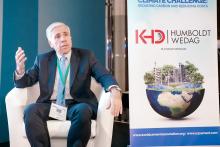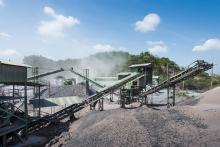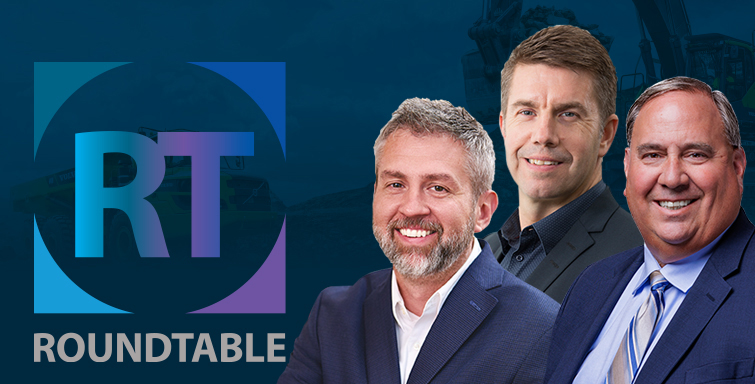
Jeremy Harsin: Jeremy is the global construction market director for Cummins Inc. where he is responsible for segment strategy development, global OEM collaborations and digital connectivity leadership. When he first joined Cummins, fourteen years ago, he installed some of the first fully-emissionised engine systems in the market. Moving from engineering to product strategy and management, Jeremy led the company’s flagship 6B engine series project, creating the value package which brought these products to market.
Pontus Evertsson: Joining Topcon Positioning Group in 2005, Michael has held positions in product, market, and business development. He is currently the company’s vice president of Sustainability and Global CSR (Corporate Social Responsibility). Before that, he led on strategic OEM relationships and a number of successful mergers and acquisitions. He is co-inventor on four technology-related patents and is an Association of Equipment Manufacturers board member, chairing the AEM Council for Agricultural Technology.
Michael Gomes: Pontus attributes his leadership skills to his experience as a military engineering officer. Now head of Product Management Region EU/INT for wheeled loaders and articulated and rigid trucks at Volvo CE, Pontus is responsible for the company’s dealer network, focusing on product expertise and market-specific information designed to keep the company’s competitive edge. He likes to use his military training effectively, promoting good communication skills across a geographically-diverse team.

Q: Jeremy, how is your company demonstrating sustainability on construction and aggregates sites right now?
Jeremy: In all honesty, it’s the same way we've done it in the past and the same way that I expect we will be doing it in the near- to medium-term future - and that's providing market-leading internal combustion engines. If you look at the latest spec product, our performance series engines are in applications all across the globe, working hard every day. Those engines are enabling sustainability because when we released these products, we took the opportunity to increase power and torque levels that manifested in downsizing at the OE level. When you downsize you typically see a fuel-economy benefit. That's a plus. We also took the opportunity to take those products to 100% blend approval on fuels like HVO (Hydrotreated Vegetable Oil) and, incremental to that, we added in functionality, such as start-stop. So, there are many different levers to increase sustainability just by using the current spec product. I expect that to continue in the near-term future and probably into the medium-term future, as well.
Pontus: We are doing the same as Jeremy. Product development is key for both conventional machines - such as new features in how you spec the products - and for new technologies like electric machines. Studies are being done on hydrogen etc., so that’s, of course, a vital part. We also do a lot of collaboration with key customers which we call the four-step approach, where you collect and examine the present data on an actual site - visualising CO2 or ton/hour for example - and then analyse it. Then you identify improvements, for example to remove waste within present production, and then you implement the improvement suggested. It can result in anything from operator training and efficiency services to installing production monitoring systems. In the future we also want to look into alternative technologies. You need to build and sustain targets. How do you sustain it and how do you improve these footprints over time? These are the questions we need to answer.
Q: Michael, there is a lot to pick up here from Pontus. As well as talking about what your company is doing to demonstrate sustainability on-site, what are your thoughts about customer collaboration?
Michael: At Topcon we embody sustainability primarily through the installation of sensors and machine control on the machine and that results in that construction equipment being operated most efficiently, reducing time and fuel. It also results in less total material moved, so that’s significant. There is a fair amount of weight in your point about in-job planning and coordination. Using the software, you can begin to coordinate the various machines and operations within the workflow. Machine control results in safer operation. When the operators have in-cab indicators and can see where they are, they have fewer work stoppages as well as having fewer exits from the machine. It makes for a safer work site because when operators are using machine control it requires fewer grade checkers to get in close proximity to the machine. With respect to your collaboration piece, at Topcon we serve the aftermarket so you can retrofit these technologies as well as work with a number of the major original equipment manufacturers [OEMs] where they build these features in, specific to their machine, their brand, their unique value proposition to their customer base. In both cases the technologies will start off in the aftermarket with a bolt-on philosophy and then slowly but surely get embedded and imbued into the machine.
Q: Pontus, we can’t have this discussion without talking about finances and the viability of contractors maximising the sustainability of their operations to win bids – and, crucially, whether you can then still make profits?
Pontus: There are a lot of regional differences. Looking at the EU, for example, some countries have incentives, some don’t. We have done studies showing that if you look at the total project cost for building a road or a big warehouse, for example, the added cost of having sustainable technology is no more than one to two percent of the total project cost. So, you have to ask yourself “are you willing to pay one percent extra or not?” because if you look in isolation at the contract for the parts and moving the material, then it becomes expensive. It’s about changing the perspective. But then, of course, there are applications around today, underground applications for example, which have huge ventilation costs which you can get rid of by moving to electric. It’s a very different picture, application to application.
Q: Pontus is saying one size does not fit all. Michael, are you willing to pay one or two percent more?
Michael: The way we look at things here, sustainability actually results in lowering long-term cost. That’s the most significant thing. Those lower costs, in many cases, may be because you’ve increased efficiency in the machine. It may be that you’re moving more material etc., or you are more efficient, and those machines have better on-time performance as well as generating less waste. Where you are coming in on target, on estimate and on budget, those things really help drive it. You’re talking about incentives and there are various Green Deal programmes around the world. Probably one of the first and easiest is adding telematics to the machine because when you do that, we have the ability to capture the data layers to prove the value proposition that we’re talking about so you can see that we have reduced costs over the longer term.
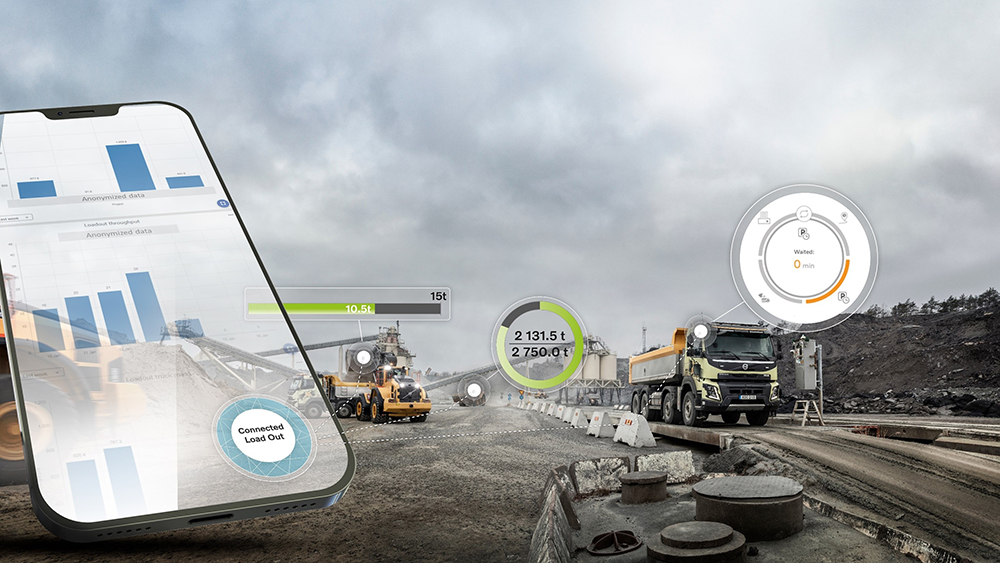
Q: Looking at the longer term, some companies aren’t willing to do that. Jeremy, what are your thoughts?
Jeremy: The answer is time-dependent and I think it is going to evolve. If you think about the requirements that are put in to affect financial viability i.e., a requirement that says you need the latest spec engines or references latest emissions, then they offer a lot of benefit now. New equipment is definitely a little bit more expensive than prior vintages but when you think about reduced fluid consumption over the life of the machine and you think about extended maintenance intervals, those types of things may not completely offset that but that puts a decent amount of money back to the bottom line for the contractors. Building on an earlier comment regarding connectivity as a prime mover, we also partner with leading telematics providers in the industry. Topcon is an example. I firmly believe that having those systems in place and with everybody working together is, without doubt, going to highlight a lot of inefficiencies and processes such as operator training and things we have talked about in past forums. You can take two people and put them in the same piece of equipment and my guess is somebody who knows what they are doing can do that job much more efficiently than somebody like me could do it. It is hard to claim those benefits in a regulatory environment but in the real world, regarding the emissions output needed to get a given job done, there are huge impacts likely to come out of that as the market further embraces digitalisation and fleet turn and all the things that we have consistently talked about. There is a lot of opportunity out there.
Q: I just want to come back to these short-term extra costs. Pontus, do you know of any emerging funding options that facilitate the transition for contractors and quarry operators?
Pontus: As I said, there are countries where governments are willing to pay extra for road projects and so on, if it can be done from a CO2 neutral perspective. There is funding already in place, but it is important to point out that there are three strong motivations for driving emission-free worksites. One is where customers want to decarbonise and have signed up to the Paris Agreement and other climate goals. Another is the impetus of emission-free work zones, which are becoming a necessity. Forget the licence to work – that is already happening. And the third one is that sustainable solutions will increasingly be more and more cost competitive. We see this in Europe, for example. It’s about getting the products out, together with the services.
Q: Michael, how important is it for those funding options to be there to facilitate this transition?
Michael: The economics of technology adoption are, for the most part, already there. In many cases the various support programmes from governments are becoming an accelerant. They increase adoption. It might be the economics of a particular technology on a bulldozer, a loader grader or a paver which accomplishes machine control on that machine, and then it’s the coordination of the additional environmental benefits or the additional savings of on-time logistics and the idea that you have less material on the road, and material is delivered to the paver on time with lower emissions. It’s a combination of economics and the additional incentives in terms of safety or the environment. You see significant opportunities on the sustainability side helping drive adoption of technology.
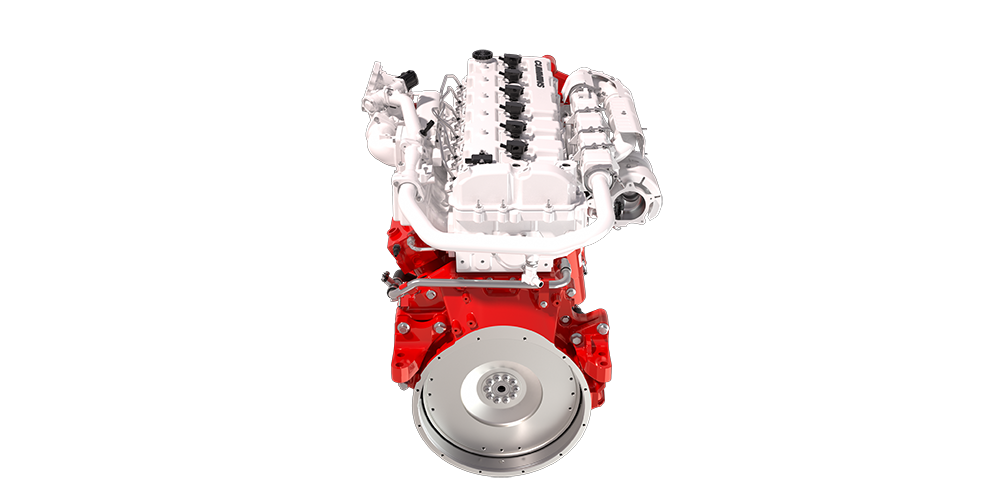
Q: If we’re looking at infrastructure, how will the necessary support capabilities be developed and financed?
Michael: We’ve talked about operational planning and design, but you also need to think about the digital twin and digitization. It’s being able to plan that work and execute the plan and it’s the ability of contractors to be able to use these kinds of digital tools to accurately assess an opportunity and then deliver with a performance on time and on budget. In many cases these are the things that truly drive and enable technology adoption.
Jeremy: It all comes back to scale – having some ability to generate scale is key. Ideal solutions are going to have a balance of CapEx and OpEx and, I believe, operational integrations. How does the technology fit into the site? When we think about future solutions, typically off-highway markets tend to have genesis in heavy-duty on-highway. So, we learn from there and build scale and then there are opportunities to port that over into off-highway spaces. Further developments in internal combustion engines are a core part of our strategy and off the back of those, future emission regs that we are designing for in relation to platforms, we expect we’re going to see more stringent off-highway emissions coming in, probably early in the next decade. When you look beyond that, those platforms are going to be the enabler for the fuel-agnostic platforms that Cummins has talked about, being able to consume hydrogen, natural gas depending on your market, diesel or biofuels on one platform. Our approach is to build scale and obviously when you build scale in those products, the storage, the generation of something like hydrogen as a fuel is very complementary. We are building that out and we are able to consume it in combustion engine form now and that is going to enable fuel cells to take over at some point in the future.
Q: Pontus, how might the implementation of new technologies affect the overall cost of ownership?
Pontus: CapEx will go up initially, but ownership cost will go down. It’s about acceptance for the longer payback. From our side, it’s also about helping customers remove risk and providing alternative business models, such as equipment as a service or different types of leasing models. In the long term the investment and product cost will go down and here we must differentiate between the power-at-site investments, the stationary investment and the product investment. So, there are different ways to drive transformation and change.
Michael: Pontus is right. When you look at the subscription model, the idea that users want the latest and greatest updates in respect of their capabilities, then we, as vendors, enable that through different business models that help both the customer as well as creating long-term benefits and reducing long-term costs.
Q: We’ve been talking about the integration of sustainability, and it would be interesting to know whether it is already a standard requirement across the board in the bidding process or is there room for improvement?
Jeremy: The disclaimer from me would be that we are usually one step removed from the bidding process, so we deal largely with OEMs and, in some cases, large end fleets. I would encourage users to verbalise those requirements through their dealers to their OE channels so that they are more visible to folks like us. I can say that it comes up more in OE conversations now than it has in the past so there are some signals there. Hard to say if it is a standard or not. It feels very much pocketed still, and when you are in isolated pockets, I come back again to that ‘scaled’ comment from the previous question. It’s really hard to profitably navigate isolated pockets of bid requirements, depending on what they are. If there is something that drives a readily available technology that can be put into the market, we should do that. If it’s something that drives technology into the mainstream, ahead of when the TCO [total cost of ownership] parity is there, without incentives they don’t make aa lot of near-term sense right now.
Pontus: Jeremy’s points are correct, but we don’t see it as standard in bids yet. What we do see becoming more common is the need to declare the CO2 and the end-to-end CO2 values throughout the project, so having the lowest CO2 is one of the bid parameters for contractors. It’s becoming a more frequent government demand. That’s the first step. We also see talk about how this product must be emission-free and CO2 neutral. It’s coming but is not yet standard. The first step, I would say, is to just declare the CO2 footprint.
Q: Why is it not yet standard across the board? Is it to do with company size?
Michael: First and foremost, I think a lot of it is to do with public perception. We certainly see that perception varies around the world. In Northern Europe, people are very tuned in to it and much more sensitive to this. In other places where they are driven by economics before the environment of the people, it’s about productivity. You are right when you say that understanding Scope 1 and Scope 2 vehicle emissions is becoming increasingly important. When I think about adoption of some of these things, one pretty obvious thing is road smoothness. Of the 50 states in the USA, there are approximately 24 that have elements of a smoothness standard, so you’ve got half adoption. It has been proven a number of times that a smooth, accurately paved road reduces the amount of material required and when it’s accurately compacted that smoothness results in lower fuel consumption from all cars travelling on it. They also have fewer repairs because there are fewer bumps, causing less damage. Thhe road top will wear more evenly and it can be replaced more efficiently when it needs to be. So, in my opinion, road smoothness is a great example of a standard that is being adopted but is not yet widely adopted. I think that is just our industry. Change is always difficult, but everybody loves progress. The difference is ‘what’s the purpose?’ and so as more people have an idea of the purpose behind the change, they begin to expand the standard and adopt it.
Q: Jeremy, adopting standards, more legislation? What role and scope are there for further legislation in this area?
Jeremy: Legislation from our perspective tends to be more emissions-output driven. I would stress, again, that the problem is when you don’t have something nationally legislated. Even a one-country solution or a one-state solution tends to drive disruption and being able to design for that, so we need standards that are more widespread. We need standards that are emissions-target driven, not necessarily technology-mandating proposals. Put the benchmark out for the industry. Let all the smart engineers in the industry figure out what the optimal solution is, one that balances that CapEx/OpEx, operational integration. That’s the way we need to approach it. It’s a good catalyst when we have pocketed incentives or pocketed requirements that say, ‘hey, implement technology X ‘. That’s probably a good way to drop some demonstration activity. It’s probably not the best way to drop something that is going to take root and be sustainable in the long term. Once those incentives go away, if you don’t have something that is driving scale, like at national level – that is usually the best case.
Pontus: I think the first step is to get the ISO and drive it from government and the bigger building companies. To have CO2 as one parameter, or any type of emissions, and highlight the importance of it. Legislation is there but it will always be different from one country to another.
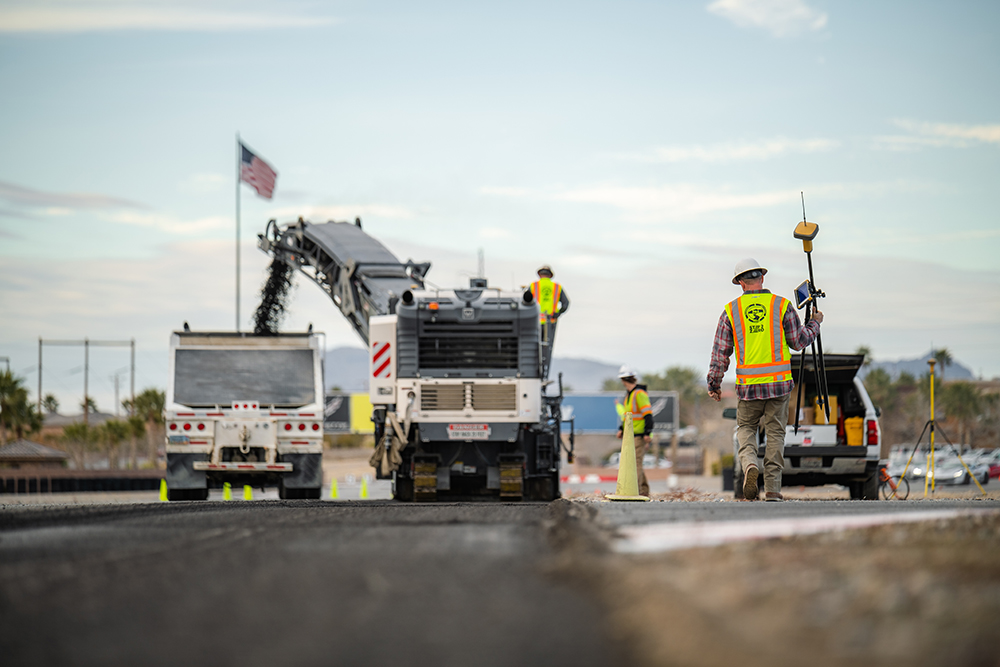
Q: That’s a problem, isn’t it?
Pontus: Yes, but also more of an opportunity. With legislation you can see change happening. It helps if you can show that TCO is lower in the country with legislation than those still using old technologies. Legislation of course helps but it is hard to implement everything in one go.
Michael: It is challenging. I live in California which has been leading a number of different aspects of regulation. I believe we really need to look at it as the glass is half-full. I’m a big believer in incentives-based adoption where we can show elements of the benefits, whether those are benefits to people economically or to the environment, and then assigning value to those benefits so we can create incentives for driving that adoption. I am a glass half-full guy so do we have the incentives out there to get our intended behaviours?
Q: I like that. When and in what circumstances do you anticipate sustainable power becoming the standard?
Pontus: It will differ from segment to segment. For example, the big mining companies are strong drivers towards sustainability already. They are downsizing from the huge trucks they use today to having multiple smaller trucks. Mining is one area which I think will move towards standardisation quite fast. But the definition of ‘fast’ might differ. In industrial handling they very often have the infrastructure in place if they are moving to electric machines. We see some customers already having their own energy production so, for them, it is only the investment and then they are running the machines for free, basically. Different types of equipment require different things.
Q: It’s very different. What are your thoughts on hydrogen, other organic fuels and also on electricity as the likely preferred sustainable energy sources?
Michael: I defer to my fellow panelists. They are much stronger on the ‘fuels thing’ than I am. You could have fossil fuels, fossil diesel or renewable or biodiesel. I don’t think you have to throw out one fuel source without understanding the existing infrastructure. The system we have today is very mature and it has evolved to that level of maturity so there is an immense amount of opportunity in being able to use elements of the structure that we already have, as well as things like ethanol-based fuel and biodiesel. Then the telematics and the data layers just act as proof of placement and proof of practice, and in documenting that they are validating the benefits that we are creating by doing the right thing.
Q: Jeremy, I’m going to take Michael’s advice and draw on your expertise.
Jeremy: It has been mentioned before that solution diversity has to be a market consideration. There are so many applications, so many use cases, that one application could be used in many different ways. A one-solution-for-one-application scenario now is unlikely for us. I don’t see a lot of opportunities in that medium- and heavy-duty space where you have something besides diesel that is going to be a TCO winner within the decade. I think that is important to know. You ask about hydrogen as a fuel. We have been pretty vocal, pretty open and positive about that. We are obviously very interested in hydrogen.
If you think about CapEx/OpEx/ integration to the worksite, one of the near-term solutions we are pretty excited about for a lot of reasons is hydrogen combustion engines, not to underestimate some of the challenges. They offer a lot of benefits for OEMs too, I am going to say, and help the ease in to decarbonisation. You don’t have to electrify the full chassis. You are really taking one engine out and putting another one in packaging tanks which is not insignificant but is a little bit of an easier lift in that regard. From an aftermarket channel, engines are something that are familiar to that group and it’s not a small group. If you look at the service network for Cummins and for other companies a whole lot of investment, time and energy has been put into this ready and capable channel. Thinking that the switch is going to flip overnight is probably short-sighted. It’s going to take time for that to happen, so you need solution diversity, one hundred per cent. Some things are going to make sense in the near term for some markets and that could be one application may make sense in use case A but not so much in use case B. It will take a while for that to play out. Technology needs time to mature. Costs need to come down. That tends to happen for our markets first in the on-highway space. We need to keep a watchful eye on the truck markets and other parts of the business that are leading the way on our behalf.

Q: Jeremy, you said things are going to take a long time. What’s your vision for the sustainable future of the construction and aggregates industry and how, in broad terms, do you think it’s achievable?
Jeremy: Solution diversity but we can’t wait for the perfect solution. We need to be exploiting things we can do now as much as we can. CO2 regulations are coming up more and more in conversation and I would expect those are probably going to find their way into the off-highway regulation space at some point. That’s going to be a very near-term improvement that we can make as an industry. Thinking about what you can bring to the market soon – combustion engines, diesel hydrogen and other fuels, we are definitely interested in the near to medium term. Batteries are a great option for compact equipment but when you get bigger than that, it is going to take a longer time to play out. Fuel cells have a longer-term place in the industry but not so much within this decade. You need to think of three things – CapEx, OpEx and maybe even more importantly, how it actually fits in the job site and how people can get the work done. There is no shortage of construction or mining needed within the ddecade so we’ve got to do what we can to enable that work to happen as efficiently and sustainably as possible.
Pontus: We believe it can be done. Collaboration will be key – and by that we mean partnerships between OEMS, government and the customer’s customer, as well as the customers’ partnerships around charging digital services. Topcon is one of them, of course. Everyone needs to contribute because sustainability and the transformation needs to be looked at from an end-to-end perspective. It’s not just about having the correct products available. It’s key to have the focus on the total solution, combining products and digital services, to get the job done. But at the same time, we must look at the total energy consumption. It’s not only about the usage phase, but everything – the production of hydrogen, or electricity or biofuels and so on. It’s important to have that in mind.
Michael: Sustainability is an ESG (Environmental, Social and Governance). It’s here to stay but when you look at it, it’s really just a balance. Profit continues to be important, but it has to be a balance with people and planet. So, increasingly institutional investors are beginning to prioritise those elements. Our ability to transparently explain and show how we are meeting those benefits is our opportunity. I am an ‘incentive space’ guy and so when we see that the incentives are aligned to push the behaviour that gets us in that realm, then that really increases the rate of adoption. I would say, for the World Highways audience, which is where we see it going and because of the rate at which those incentives and opportunities will appear, I believe that you will see many more aspects of ESG and sustainability being adopted. ESG awareness and sensitivity are here to stay. It’s now in our landscape and so the question is how do we align to that change?


